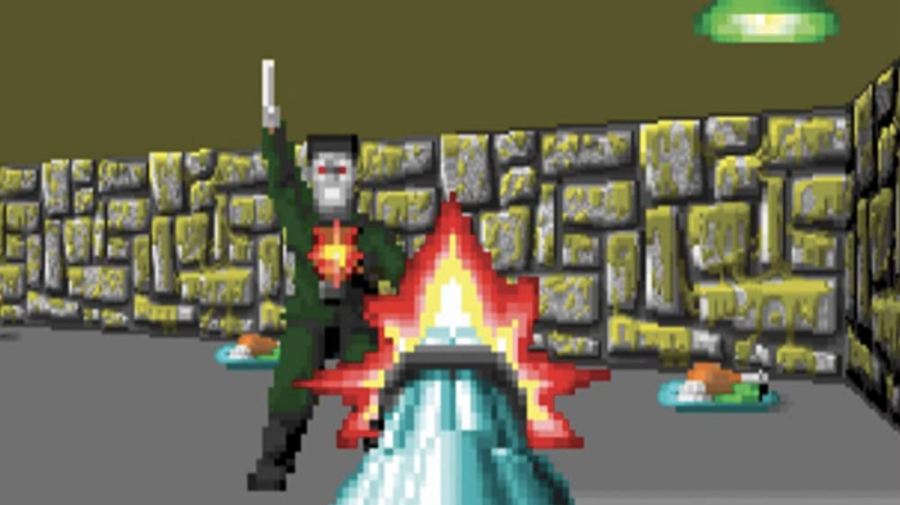
If you’ve spent some time in your life playing video games, you might be familiar with the experience of seeing something new — a new perspective, a new controller, a hyper-realistic cut-scene, you name it — and feeling totally overwhelmed. It feels like you’ll never get used to it, but then, pretty soon, by some miracle, you manage to adjust and adapt. As a person who is old enough to have had an original Nintendo console as a kid, this scenario has happened more times to me than I’d care to admit.
This month marks the 30th anniversary of the groundbreaking first-person shooter game Wolfenstein 3D. I have vivid memories of being at a family dinner with friends of my parents, seeing their kids play Wolfenstein 3D on their computer; my mind was completely blown. Everything seemed to be moving so fast; everything seemed to be coming right at me. I had never seen anything like it.
While there were first-person video games before Wolfenstein 3D and much better ones that came after it and built on its legacy, its release was a watershed moment in the history of wasting time on the computer. Here, we’ll get into the history of the genre, why Wolfenstein 3D felt like such a big deal at the time, and why perspective is always ground for interesting experiments in video games.
The Evolution of First-Person Perspective in Video Games
It seems like a pretty obvious development now, but it took a while for people to figure out how to implement first-person perspective into a virtual experience. The first video game is generally considered to have been Tennis for Two, created in 1958 by a man named William Higinbotham. It involved a side-view of a tennis court crudely rendered on an oscilloscope screen. The ball, as you can imagine, was sent back and forth. It was a lot like Pong, which came along 14 long years later.

Of course, creativity cannot be stopped. In 1973, Maze War, the first game that could technically be called a first-person shooter, came out. That means each player could move about the titular maze in such a way that the view would be what you might see if you were plopped into the maze yourself. While the rendering was still profoundly simple — green lines producing a series of 3D hallways — Maze War captured all the most important elements of first-person video games.
First-person perspective had been used prior to Maze War in simple racing games or in gallery shooter games similar to the famous Nintendo game, Duck Hunt, in which a player fires at moving targets on an otherwise static screen. Maze War’s addition of other, networked players added an element of a living, changing, unpredictable experience that is at the center of everything that’s so addictive about video games. As Maze War creator Steve Solley put it, “Maze was popular at first but quickly became boring…and soon the idea for shooting each other came along, and the first-person shooter was born.”
Getting to Wolfenstein 3D
In the almost 20 years between Maze War and Wolfenstein 3D, a lot happened in video games. I’m not going to go into all of that here, but suffice to say that by 1992, the technology of video games had advanced to the point that an evolutionary leap was possible. Wolfenstein 3D, due to a combination of factors, was the game that capitalized on the moment.

First, there was the game itself. In Wolfenstein 3D, you are William “B.J.” Blazkowicz, an American spy who must first escape from the fictional Nazi prison, Castle Wolfenstein, and then stop a Nazi plot to create an army of zombie mutants. The game culminates in a battle against Adolf Hitler in some sort of robotic, machine-gun wielding suit.
All of that plot is secondary to the mechanics of the game, though. More than any of the first-person games before it, Wolfenstein 3D had smoothness to its movements, and you could move and look around in 360 degrees. The graphics seem absurdly rudimentary now, but they looked incredible in 1992. It’s hard to go back in time and remember how things felt, but trust me: playing Wolfenstein 3D felt like a sea change. For the first time, a video game made me kinda feel like I was there.
First-Person Shooters Since Wolfenstein 3D
Almost immediately after Wolfenstein 3D, even better first-person shooters started popping up as the company that produced it — id Software — followed it up with Doom in 1993 and Quake in 1996. Doom, in particular, took everything that Wolfenstein 3D did and made it even bigger: higher resolution graphics, smoother gameplay, and amped-up levels of violence and gore. Doom was such a major hit that it ended up spawning a movie starring The Rock in 2005.

In the context of video games though, these games, along with 1994’s Descent from Parallax Software, created the foundation for everything that came after in the genre of first-person shooters. Over the next decade, Halo, Medal of Honor, Call of Duty and other first-person shooter franchises started coming out. As of today, these franchises have been pumping out first-person shooter content for two full decades, and they show no signs of slowing down.
Contemporary first-person shooter games are hyper-realistic. The way the first-person perspective moves through any given landscape feels uncanny — almost human. Looking at Wolfenstein 3D now doesn’t give you that feeling, but I promise you: back in the early 90s, it did. The DNA of today’s games is right there for you to see.
Experiments in Perspective
Of course, first-person perspective in video games went beyond the incredibly simple idea of shooting stuff with a gun. It’s always been true that video games are a version of virtual reality, but the first-person perspective takes that truism to its purest level. For example, 1993’s Myst, a computer game in which the player explores a mysterious island through a series of puzzle challenges, was a much quieter exploration of the possibilities of first-person perspective, and it managed to be an enormous hit in the early 1990s too.
I love first-person shooters. They’re exciting to play, and the experience of playing them with and against friends is really hilarious and fun. Still, running around shooting stuff and blowing stuff up gets old after a while, doesn’t it? Maybe after all these decades of exploring the first-person perspective in video games, the most interesting experiences and experiments are happening elsewhere.

That brings me to Everything, the 2017 game from the artist David OReilly. Everything isn’t in first-person perspective — the player sees the vessel through which they move around and explore the procedurally-generated universe. The innovation is that the vessel changes; as you wander around, you can embody the consciousness of anything you see. Want to be a cow? Be a cow for a while. Want to be a blade of grass that a cow might eat? Go for it.
Everything has no goals beyond exploration, really. While you wander around, you listen to quotes from the philosopher Alan Watts. The whole thing is very meditative. Nevertheless, when I played it for the first time, I found myself thinking about Wolfenstein 3D and the first-person shooter games of my adolescence. I thought about how every so often a video game comes along that changes the way I think about things — the way I experience the world around me. Video games can be overblown and silly, and maybe we spend too much time and energy on them, but sometimes they are a reminder of our capacity for creativity and wonder, too.

 Seth Landman
Seth Landman




